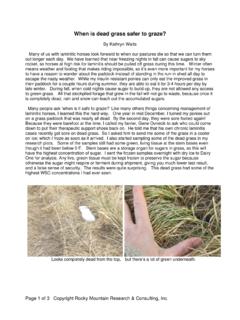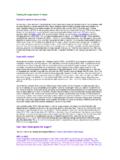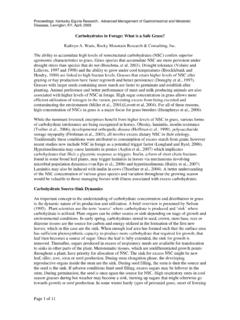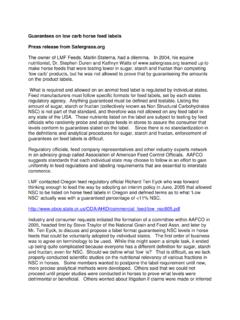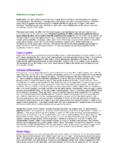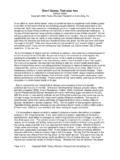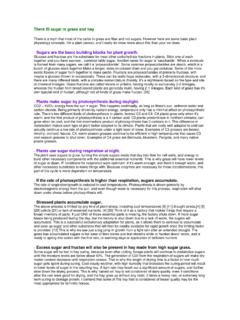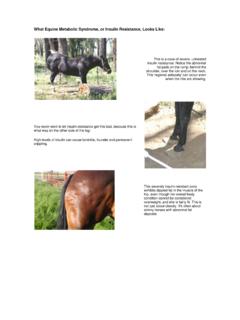Transcription of Pasture Management- Reducing the Risk
1 Vet Clin Equine 26 (2010) p. 361-369. Pasture management to Minimize the Risk of Equine Laminitis Kathryn Watts, BS, Research Director Rocky Mountain Research & Consulting, Inc., Center, CO. This work was funded by the Animal Health Foundation, Pacific, MO. Introduction Grass breeders have historically developed improved cultivars with an increased ability to accumulate high concentrations of sugar, starch and fructan, collectively known as non- structural carbohydrates (NSC) (1) (2). Grasses high in NSC have increased calories, stimulate microbial fermentation, and increase utilization of excess nitrogen in the rumen of cattle (3). Higher NSC concentrations lead to increased animal intake and subsequent increased animal daily gain (4). While these increases in carbohydrate content of forages have benefited meat and milk producers, they have not necessarily been good for domesticated equids. If animal managers better understand the effects of environmental conditions and cultural practices they are in a better position to successfully manage horses prone to laminitis.
2 Most horses that have recovered well from a bout with laminitis can tolerate some grazing if the Pasture is properly managed, and horses are removed to a dirt paddock during times when NSC peak to due uncontrollable environmental conditions. These same conditions will affect the NSC of hay as well, so avoidance of green grass will not always prevent a relapse. Factors Affecting NSC Content of Grass Concentrations of NSC are highly dependent on environment, plant species, and stage of development. Cool-season grasses grown in cool temperatures accumulate sugars, starch, and fructan (5). Warm-season grasses accumulate only sugars and starch. Accumulation of NSC in grass occurs in response to stress, allowing those that accumulate the most to have a competitive advantage when the stress is over. Cool season grasses that evolved in climates with severe cold or frequent drought tend to be highest in the ability to accumulate NSC.
3 Many warm season grasses go completely dormant under severe stress and therefore do not need to fuel long periods of low level metabolism to survive winter. NSC concentrations have been shown to vary over time being low in the morning and high in the afternoon (6). Temperatures at or below 10 C caused increased WSC (sugar+ fructan) levels in perennial ryegrass (7). Perennial ryegrass with increased WSC levels are more competitive in mixed stands, more persistent after grazing with increased regrowth rates than perennial ryegrasses lower in WSC (8). In orchardgrass, water-soluble carbohydrates increased by 40% of dry matter as drought stress increased (9). Page 1 of 10. Vet Clin Equine 26 (2010) p. 361-369. Species A study to compare NSC concentration of various grass selections was conducted in Colorado, USA in a high mountain valley where the sunny, cool climate creates optimum conditions for accumulation of NSC.
4 Four replications of 24 species in randomized blocks were sampled in the late afternoon for maximum daily NSC concentration. The site was cut twice per season to simulate hay production. Plots were fertilized 3 times per growing season and irrigated to simulate optimum commercial production. Samples were analyzed by a modified Megazyme method that included acid hydrolysis to better quantify the long chain fructan inherent to grass. The varieties grown commercially in the area contained between 17-22% NSC on a dry matter basis when averaged over 8 harvests throughout the growing season. Perennial Ryegrass (Lolium perenne) > Timothy (Phleum pretense) >. Crested Wheatgrass (Agropyron cristatum) > Tall Fescue (Festuca arundinacea ) > Orchard (Dactylis glomerata) > Redtop (Agrostis alba) > Garrison Meadow Foxtail (Alopecurus pratensis) > Kentucky Bluegrass (Poa pretense) > Meadow brome (Bromus riparius) >.
5 Smooth brome (Bromus inermis) > blue and Sideoats grama (Bouteloua gracilis and B. curtipendula ). The five lowest in NSC out of 24 were species native to the region, and had not gone through any selection programs for increased nutritional density or increased production. The two Grama grasses both averaged < 10 % NSC dm. Fig. 1. NSC of some selected grass species averaged over 8 harvests, 2 consecutive years. Non Structural Carbohydrates -Season Average 30. 25. % dm NSC. 20. 15. 10. 5. 0. l ss s hy ue a .B e ue e e p d s d ai om ea ras m m ar m to as ar xt ra ot sc ra . M bro ro h . M Red ch gr Fo eg g r m rc Fe G. an d b ye r Ti lu O. O. d d e m ll Bl R. ea ea tB. lu t. L. Ta .S. Po B. W. r. ig M. en Pe B. h eg ar .K. ac M. G. R. G. C. 2004 2005. There is a tendency to incorrectly assume that NSC concentration is inherent to a species of grass. It is more correct to view NSC content as genetic potential that must be triggered by appropriate conditioning before the characteristic is expressed.
6 Grass grown under one set Page 2 of 10. Vet Clin Equine 26 (2010) p. 361-369. of conditions can vary widely in carbohydrate content when grown in a different environment. Perennial Ryegrasses, known for being very high in sugar in the United Kingdom, were found to be only average when grown in New Zealand's warmer climate (7). Most improved species of grass, common in pastures and hay fields around the world, are capable of accumulating levels of NSC that are inappropriate for laminitic horses under certain conditions but may be safe under other conditions. When seeking low sugar forage, it is best to focus on conditions that do not trigger high sugar traits. Temperature Temperature has a great effect on NSC content of Pasture plants. Amount of fructan accumulated is greatly influenced by day/night temperatures, particularly just prior to harvest. The enzymes that facilitate respiration of sugars slow below 5 C and cease below freezing.
7 When grown for 4 weeks under controlled conditions, leaf tissue from cool season grasses subjected to 10 C days and 5 C nights averaged 3 times higher in NSC compared to 25 C. days and 15 C nights (10). Grasses grown under cool conditions accumulate sugars, which in turn triggers the formation of storage carbohydrates. Under cool conditions fructan formation will commence in most cool season grasses and certain broadleaf weeds, while starch will accumulate in warm season grasses and clover. Even mature, high fiber grasses can contain high levels of NSC when subjected to cold temperatures as long as some green tissue remains (11). The same respiratory enzymes become more efficient under the influence of warm temperatures. Sugars may be rapidly metabolized in hot weather, making C3, cool season grasses in summer much lower in NSC, especially if other inputs such as water and nutrients are not limiting growth.
8 This is demonstrated by the data in Fig. 2 which was generated from the same study mentioned previously. Kentucky Bluegrass (Poa pratensis), that averaged 25% dm NSC in early spring, decreased to 15% under optimum growing conditions during summer, NSC. returned to 20% after the onset of freezing temperatures in fall. The average NSC dm across 24 species was approximately 21% in spring, 13% in summer, and 18 % in early fall. The highest total NSC at any harvest date was dm in Perennial Ryegrass during late fall after repeated freezes and desiccating winds. Perennial Ryegrass is not sustainable in the region where this study was conducted, and was probably under more stress than the better adapted species. Page 3 of 10. Vet Clin Equine 26 (2010) p. 361-369. Climax Timothy % NSC Perennial Ryegrass % NSC. 35. 40. 30 35. 25 30. NSC % dm NSC % dm 25. 20. 20. 15. 15. 10 10. 5 5. 1 2 3 4 5 6 7 8 1 2 3 4 5 6 7 8.
9 Harvest Harvest Garrison Meadow Foxtail % NSC Potomac Orchard, % NSC. 35. 35. 30. 30. 25. NSC % dm 25. NSC % dm 20 20. 15 15. 10 10. 5 5. 1 2 3 4 5 6 7 8 1 2 3 4 5 6 7 8. Harvest Harvest Fawn Tall Fescue % NSC Regar meadow Brome % NSC. 35 35. 30 30. 25. NSC % dm NSC % dm 25. 20 20. 15 15. 10 10. 5 5. 1 2 3 4 5 6 7 8 1 2 3 4 5 6 7 8. Harvest Harvest Side oats Grama % NSC Ginger Kentucky Bluegrass 35. 35. 30. 30. 25. NSC % dm 25. NSC % dm 20 20. 15 15. 10 10. 5 5. 1 2 3 4 5 6 7 8 9 1 2 3 4 5 6 7 8. 2004 2005. 2004 2005. Figure 2. Seasonal variation of nonstructural carbohydrate (NSC) in grasses grown in Colorado, USA. The green vertical lines represent removal of hay crop, and application of nitrogen fertilizer. Harvest 1, 2, 3 - May, Harvest 4 - July, Harvest 5 - August, Harvest 6 - September, Harvest 7- October, Harvest 8 November. Page 4 of 10. Vet Clin Equine 26 (2010) p. 361-369. Conversely, C4, warm season grasses commonly grown in tropical regions may peak in starch with up to 19% in leaf tissue, when conditions are sunny and hot (12).
10 C4 grasses have a different morphology and metabolism than C3 grasses. Tropical regions often have a cloudy, rainy season and a season of drought when grass goes dormant. Plants that evolve there must be able to make better use of sunlight when it is available during the wet season. C4 grasses native to temperate regions, such as the Grama grasses in the intermountain region of the USA, grow very quickly in response to warm soil and summer rains and go dormant after the soil dries or cold weather returns. These grasses have no need to accumulate NSC. As illustrated by the data in Fig. 2 the Grama grass remained low in NSC. throughout its life cycle. C4 grasses will not grow during cold weather; therefore data was missing during periods when C3 grasses were peaking in NSC. Stage of Growth Hay growers try to cut just as grass starts to develop seed heads. This is when grass has maximum yield, but before nutritional quality start to decrease.
